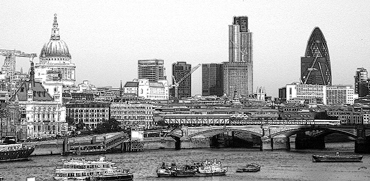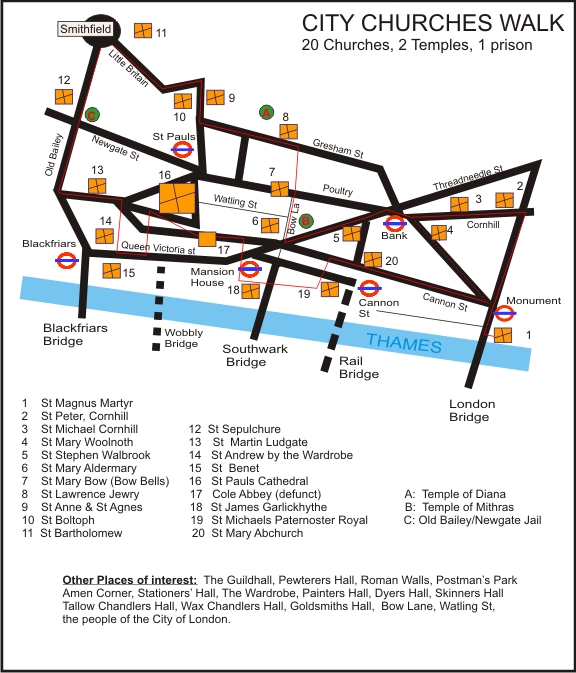 click on map to enlarge INTRODUCTION: skip
Wren's churches, with St Paul's for scale  The City comprises a 'square mile' built on the ancient Roman town of Londinium (see our history page for details). London saw itself, politically speaking, as the new (pagan) Rome and modeled itself accordingly - in some ways the monarchs Elizabeth and Charles II saw themselves as harbingers of a new Augustine age. One figure it's impossible to avoid is that of Sir Christopher Wren, a physicist, who stamped his mark on the City, not just in St Pauls Cathedral, but in his 51 post-fire churches that punctuate the warp and weft of its narrow streets - you're never more than 400 metres away from one of his creations. This walk takes 2-3 hours, depending on how long you stop and how many places of refreshment you visit. You can do it any time of the year, but we'd recommend doing it in November or December, when there's a mounting spirit of Christmas future, and many of the churches remain open longer, to sell charity christmas cards, and besides, it's more Dickensian - you may even get mist or fog. See also our city page. My map is schematic, you'd be advised to have an A-Z or print off this map for better navigation - the churches are marked as crosses, as shown in the arrow. A good vade mecum to the city churches is here THE WALK  We start at MONUMENT
STATION - although this walk is
circular and you could join it anywhere on route, we
prefer to start and end at Monument as it gives you
access to three tube lines. Apart from the monument
itself, if you haven't visited it, and it's worth the
climb, Monument Station sits close to one of the best
views of the Pool of London, you might want to grab a
photo from London Bridge. We start at MONUMENT
STATION - although this walk is
circular and you could join it anywhere on route, we
prefer to start and end at Monument as it gives you
access to three tube lines. Apart from the monument
itself, if you haven't visited it, and it's worth the
climb, Monument Station sits close to one of the best
views of the Pool of London, you might want to grab a
photo from London Bridge. This bridge is featured in almost every newscast when they want a general shot for 'City workers' or 'Londoners' - it also features in TS Eliot's poetry as the numbers of nameless workers crossing the bridge reminded him of the gates of hell. "Through me is the way into the woeful city; through me is the way into eternal woe; through me is the way among the lost people... there came so long a train of folk, that I could never have believed death had undone so many." Inferno, canto 3 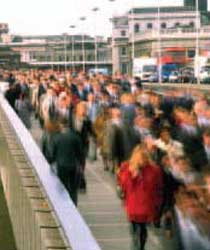
Strangely enough, it's in Limbo that Dante meets Virgil, his guide to the nether regions. As to the City, we see it as being further down in the circles of hell, with the usurers. Of course the City is the old bit of 'London' - where Shakespeare lived and most of the hot action of previous centuries took place. Shakespeare worshiped at St Helens, which features on another walk, but if you want to add it into this one, it's just off Gracechurch St, very close to Leadenhall Market. If you do this detour you'll pop into the map at the top of Threadneedle street. Church number one is ST MAGNUS MARTYR Lower Thames street - the end place of our City walk, this church dates back prior to the Norman Invasion of 1066, but there is only hard evidence from the 12th century. Rebuilt by Wren after the Great Fire, it stood at the foot of the old London Bridge and as such the frontage has been much altered. It partly burnt down again in the 18th C but amazingly survived the Blitz. TS Eliot admired the church, and described it in 'The Waste Land'. Has a remarkable organ from 1712 and plenty of statues, monuments and gilded sword rests.  From here retrace your steps up to Monument station at the north end of London Bridge and then either go up Gracechurch St or King William St. ST PETER CORNHILL and ST MICHAEL CORNHILL are two neighbouring churches on Cornhill, site of the Roman Forum. St Peter's is hardly ever open but St Michael's is worth popping in. It was rebuilt in 1671 after the great fire, and further remodeled by Gilbert Scott in a gothic revival style. You can skip them both if you want and go straight up King William Street from Monument. If you do, St Clement Eastcheap is on your right as you walk north. Founded around 1222 when there was a priory on the site. The current, rather bland church, was originally built by Wren in 1685. Together with St Clement Danes it claims to be the source of 'Oranges and Lemons say the bells of St Clements'. East Cheape is the East Market in Saxon (there was also a West Cheape). Strangely Chinese firms avoid the area, like they do the number 4 as any association with Cheap in the modern sense of the word is bad luck. 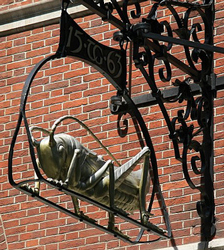 At the top of King William St is ST MARY WOOLNOTH . Strangely fronted, as Hawksmoor, the designer, used more Palladian models than Wren, it sits on the corner with Lombard street. The Woolnoth refers to its founder, Wulfnoth a Saxon prince, on the site of the Roman temple of Concordia. Seems to have existed in its present form since 1273, and the Great Fire damage was repaired by Wren, and rebuilt later by Hawksmoor. The interior is inspired by the craze for things Egyptian which was prevalent at the time. Bank tube station is excavated directly beneath. Edward Lloyd, who founded Lloyd's coffee house, which became Lloyds of London is buried here. It is now a guild church. If you look down Lombard street, to your right, you can see the signs of trade (eg a cricket) which date back to when the Lombards (yes, actually from Lombardy, in Italy) ran most of the banks. From here, 'Bank' the temple of Mammon, aka The Bank of England is ahead of you. To your right is the Royal Exchange (pop in to see the half-hidden paintings of London history round the walls), and on your left, at 7 o'clock is Walbrook, behind the Mansion House. 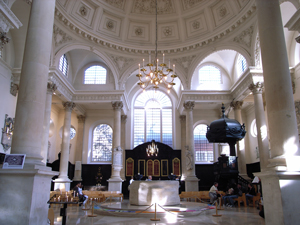 ST
STEPHEN WALBROOK a really lovely
church, in fact more like a pagan temple, with Henry
Moore's massive carved stone altar in the centre.
After St Barts, our next favourite church. Amazing
acoustics. Known because Chad Varah, the vicar,
founded The Samaritans there in 1953. Nice bloke. Well
worth walking into and just sitting and letting the
space wash over you - we put it on a par with
Orsanmichaele in Florence for the spirituality of the
space. There's been a church here since the 7th
century, but the current one, with the dome (a
rehearsal for St Pauls) is by Wren. The site around
the church is under development and we fear for the
area. The plans include moving the Temple of Mithras
back to its original site near the church (vide
infra). A guide to the church is here From here
take Queen Victoria St southwest. On your left, near
the junction with Queen St you pass the ST
STEPHEN WALBROOK a really lovely
church, in fact more like a pagan temple, with Henry
Moore's massive carved stone altar in the centre.
After St Barts, our next favourite church. Amazing
acoustics. Known because Chad Varah, the vicar,
founded The Samaritans there in 1953. Nice bloke. Well
worth walking into and just sitting and letting the
space wash over you - we put it on a par with
Orsanmichaele in Florence for the spirituality of the
space. There's been a church here since the 7th
century, but the current one, with the dome (a
rehearsal for St Pauls) is by Wren. The site around
the church is under development and we fear for the
area. The plans include moving the Temple of Mithras
back to its original site near the church (vide
infra). A guide to the church is here From here
take Queen Victoria St southwest. On your left, near
the junction with Queen St you pass the TEMPLE OF MITHRAS details . There's a reconstruction at the Museum of London - Mithraism was a forerunner of Masonry in its cliquiness and gradations of worshippers shown 'mysteries'. Mithras was also linked with much christian imagery. Where Queen Victoria St hits Bow Lane is ST MARY ALDERMARY . An old church, linked to the Cordwainers guild, mostly notable for the painted organ pipes - John Milton got married here and the church has links with the Chaucer family. It has its own website though a good guide to the church is here. Like many city churches, the original was mostly destroyed in the great fire of 1666 but enough remained to delay the building (while Wren and his mates got on with altogether new constructions) and it was left to a Wren pupil to do the reconstruction in around 1680. 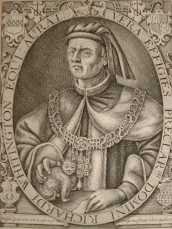 If you go in the
main door of the church and out the other you're in
the old Roman area of Watling Street/Bow Lane...
explore it at your own pace - make sure you poke into
the alleyways - it's a very old part of London and
full of City culture. There are plenty of pubs and
restaurants around here as well if you're feeling in
need of refreshment. At the north end of Bow Lane is ST MARY-LE
BOW . If you were born within
sound of the bells of this church you're a cockney
(coken ey - rotten egg). The church you see was almost
totally reconstructed after the war, when it was
extensively damaged, and only re-opened in 1964. Its
name is not French, but comes from the bowed arches in
the 11th C crypt (originally it was Sancta
Marie-de-Arcubus). A guide to the church is here. If you go in the
main door of the church and out the other you're in
the old Roman area of Watling Street/Bow Lane...
explore it at your own pace - make sure you poke into
the alleyways - it's a very old part of London and
full of City culture. There are plenty of pubs and
restaurants around here as well if you're feeling in
need of refreshment. At the north end of Bow Lane is ST MARY-LE
BOW . If you were born within
sound of the bells of this church you're a cockney
(coken ey - rotten egg). The church you see was almost
totally reconstructed after the war, when it was
extensively damaged, and only re-opened in 1964. Its
name is not French, but comes from the bowed arches in
the 11th C crypt (originally it was Sancta
Marie-de-Arcubus). A guide to the church is here. It was the bells of Bow Church that made Dick Whittington turn again (he'd been beaten up by a cook and was down on his luck) and come back. He was a real character (as was his cat) and he's celebrated in Pantomines around christmas. Sometimes they get a bit Rabelaisian 'Dick Whittington and his Amazing Pussy' was one (rather blue) variant. From Bow Church, head north, across Cheapside (taking either Milk Lane or Honey Lane/King St - yes, this is the land of milk and Honey for bankers..) at the top, on Gresham St is ST LAWRENCE JEWRY sits in the courtyard of the Guildhall - largely destroyed by German bombs, but rebuilt, with horrid modern extensions. On the front is the Lord Mayor's coach, inside is a clock museum and an art gallery with a good collection of pre-Raphaelite paintings. There's a good description of the church here which we won't duplicate. But in brief - the term 'Jewry' refers to this being a Jewish quarter of London, the church dates from 1136 and is built over the remains of the Roman amphitheatre, which you can see in the Guildhall museum - like most city churches it was damaged in the great fire and was rebuilt in 1677 and again in the 1950s. On the corner of Aldermanbury and Love Lane is the site of a temple to Diana, latterly the church of ST MARY ALDERMANBURY, destroyed in the war and shipped as rubble to Missouri, where it was rebuilt. Information on the former temple is scant - we were told about it by an archeologist friend who specializes in pagan sites. Presumably this would be where gladiators would consecrate their arms before battle in the nearby Amphitheatre, but it all remains conjectural. The small park houses a memorial to John Heminge and Henry Condell, friends of Shakespeare's, who brought together the first folio of his plays. A guide to the church is here. Take Love Lane, then Oat lane (through the chequer-faced building), passing the Guild Hall of the Pewterers and straight through into Noble St, where there's a viewing platform for the old Roman wall and fort. Behind the Roman wall is the Lutheran church of ST ANNE + St AGNES which is sadly often closed. Website  Turn
right onto St Martins-le-Grand and on your left is ST BOLTOPHS
ALDERSGATE . One of the four St
Boltoph's built near the old gates of the city for the
relief of travelers, named after the 7th century Saxon
Abbot Boltoph who was a precursor to St Christopher
(an entirely fictitious saint, now exposed and
decanonised). Only slightly damaged in the Great fire,
but was rebuilt in 1788 anyway. Much nicer inside than
its outside would give hint to - the nearby Postman's
Park abuts the yard, laid out as a park
itself. Underneath the shelter in the yard are over a
hundred plaques to brave citizens who risked their
lives saving others. The Museum of London is nearby if
you want to have a look - it's highly recommended and
is very child-friendly. From the west side of the
park, turn right on Edward St then left onto Little
Britain and follow that to Smithfield. On the West
side of the roundel is Carluccio's - a good place for
lunch. Turn
right onto St Martins-le-Grand and on your left is ST BOLTOPHS
ALDERSGATE . One of the four St
Boltoph's built near the old gates of the city for the
relief of travelers, named after the 7th century Saxon
Abbot Boltoph who was a precursor to St Christopher
(an entirely fictitious saint, now exposed and
decanonised). Only slightly damaged in the Great fire,
but was rebuilt in 1788 anyway. Much nicer inside than
its outside would give hint to - the nearby Postman's
Park abuts the yard, laid out as a park
itself. Underneath the shelter in the yard are over a
hundred plaques to brave citizens who risked their
lives saving others. The Museum of London is nearby if
you want to have a look - it's highly recommended and
is very child-friendly. From the west side of the
park, turn right on Edward St then left onto Little
Britain and follow that to Smithfield. On the West
side of the roundel is Carluccio's - a good place for
lunch. 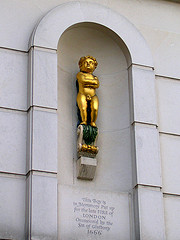 However, turn right as you
emerge into the place and you'll see the impressive
gatehouse to ST BARTHOLOMEWS See our
city walk pages for details. This is perhaps our
favourite of the City churches and the only one, apart
from St Paul's which is a must. You've probably
already seen it, though, as Four Weddings and a
Funeral, Shakespeare in Love, The End of the Affair
and Elizabeth: The Golden Age were shot here. Fairly
frequently the whole church is closed for a whole week
for filming. Opening times can be had from the
church's website and there's a
good historical church guide here However, turn right as you
emerge into the place and you'll see the impressive
gatehouse to ST BARTHOLOMEWS See our
city walk pages for details. This is perhaps our
favourite of the City churches and the only one, apart
from St Paul's which is a must. You've probably
already seen it, though, as Four Weddings and a
Funeral, Shakespeare in Love, The End of the Affair
and Elizabeth: The Golden Age were shot here. Fairly
frequently the whole church is closed for a whole week
for filming. Opening times can be had from the
church's website and there's a
good historical church guide here From Smithfield, turn south on Cockspur street and head down to Newgate.  On your right as you go down is the Pye
Boy, which marks the furthest extent of the great
fire. On your right just as you hit Holborn Viaduct
is HOLY SEPULCHURE WITHOUT NEWGATE,
another church founded by Henry I's jester, Rahere
after he gave up the cap and bells for the Prior's
cowl in the early 12th century. It was here that the
Knights of the Crusade set out for their disastrous
and bloody campaigns in the east. It also
provided (little) succor to prisoners in Newgate Jail,
destined for execution. There was a tunnel dug under
the road (you can still see the entrance) where to
allow the vicar to visit the condemned and ring a
little bell for them, which must have warmed the
cockles of their heart no end (there's reference to
this ritual in Macbeth). The husband of Pocahantas Cpn
Smith, is buried here - she's in Gravesend, 30 miles
away to the east. Has strong associations with
musicians and a strong reputation for the quality of
its music - Henry Wood, founder of the Promenade
concerts was christened and buried here. It's also the
headquarters of the Royal School of Church music and
concerts here have a good reputation.
website. See also here for detailed history and
guide On your right as you go down is the Pye
Boy, which marks the furthest extent of the great
fire. On your right just as you hit Holborn Viaduct
is HOLY SEPULCHURE WITHOUT NEWGATE,
another church founded by Henry I's jester, Rahere
after he gave up the cap and bells for the Prior's
cowl in the early 12th century. It was here that the
Knights of the Crusade set out for their disastrous
and bloody campaigns in the east. It also
provided (little) succor to prisoners in Newgate Jail,
destined for execution. There was a tunnel dug under
the road (you can still see the entrance) where to
allow the vicar to visit the condemned and ring a
little bell for them, which must have warmed the
cockles of their heart no end (there's reference to
this ritual in Macbeth). The husband of Pocahantas Cpn
Smith, is buried here - she's in Gravesend, 30 miles
away to the east. Has strong associations with
musicians and a strong reputation for the quality of
its music - Henry Wood, founder of the Promenade
concerts was christened and buried here. It's also the
headquarters of the Royal School of Church music and
concerts here have a good reputation.
website. See also here for detailed history and
guide  For a taste of Newgate
Prison, repair to the Viaduct tavern, next door, where
they still have cells from the prison in their cellar.
Please buy a pint or something here as a member of the
bar staff has to accompany you down into the cellar of
the pub. The cells are suitably dank and cheerless.
See also here. For a taste of Newgate
Prison, repair to the Viaduct tavern, next door, where
they still have cells from the prison in their cellar.
Please buy a pint or something here as a member of the
bar staff has to accompany you down into the cellar of
the pub. The cells are suitably dank and cheerless.
See also here.Regulations posted in the yard of the prison include "Any person breaking wind in the ward from seven A.M. to ten P.M. shall forfeit 1d" The site of Newgate Prison is now occupied by the Old Bailey, or the Central Criminal Court as it's known to clients. Well worth sitting in on a trial here. Proceed down the street called 'Old Bailey' and take Warwick Passage under the prison - the visitors entrance is on your left. Otherwise keep on through the passage and you emerge onto Warwick Square, which leads to Warwick Lane. Turn right. 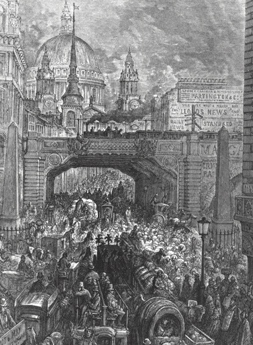 Warwick Lane becomes Ave Maria Lane and on your right are AMEN CORNER (cf the '60s band of the same name) and AMEN COURT. These are grace and favour houses belonging to the Church of England... legend has it this was the escape route from Newgate Gaol and some people have claimed to see a black figure prowling late at night. However after a few pints of beer, a cannon of the church could easily be mistaken for a ghost. Famous residents include Cannon Collins, who was active in the anti-apartheid movement. The place gets it's name from Marian processions of monks (Greyfriars and Blackfriars), fingering their rosaries, and presumably the choirboys, and here they said 'Amen' - the area is also known as paternoster row - and extends into the area to the left which leads into St Paul's Churchyard. Paternoster row is the publishing centre of old London, and as you proceed south on Warwick Lane you can cut right into Stationers' Court to see the guildhall, and out onto Ludgate Hill - the classic viewpoint for St Paul's Cathedral and chronic congestion point in Victorian London. The rail bridge was demolished in the 90s with the creation of the Thameslink service, now running underground. We'll come to St Paul's a little later. ST MARTIN LUDGATE Website has links to the Penn family - William, whose son founded the Pennsylvania was married here in 1643. There was a medieval church on the site from 1174, but the current one dates from 1703 - one of the last churches to be rebuilt after the great fire. Inside the church are preserved bread shelves, where donated bread not used in communion would be given to the poor. My mother remembers this tradition from her church in Stafford in the 1930s. The legacy still continues as some bakers put out unsold bread for takers - eg in Covent Garden where it's hung on a special hook outside the shop.. Cross Ludgate Hill (we'll come to St Paul's soon, honestly) and go through the archway into Ludgate Circus. Continue south to Burgeon Hill (Dean Burgeon, poet and biblical scholar has an academic hood named after him, and the society which concerns itself with academic and ceremonial drress is also named after him) and turn left onto Ireland Yard. You may have heard of Scotland Yard but it's Irish equivalent is more famous because Shakespeare lived here, buying the gatehouse in 1613. Actually it's named after the family who owned it and is on site of the huge Blackfriars Priory. The whole area is concerned with ceremonial robing.. the Wardrobe, just across St Andrew's Hill is a relic of the King's Wardrobe, where he'd have stored the heavy ceremonial gowns for processions.  ST ANDREWS
BY THE WARDROBE on St Andrew's Hill
has Perhaps the best name of any church, it sounds
like it's out of 'The Lion, the Witch and The
Wardrobe' but it isn't. Another perennial film and TV
favourite - see our city walk for more colour. The
exterior, particularly on St Andrew's Hill is more
interesting than the rather plain interior.
Website From St Andrews follow Wardrobe
Terrace to Knightrider Street. On your right as you
cross Godliman St you can see ST ANDREWS
BY THE WARDROBE on St Andrew's Hill
has Perhaps the best name of any church, it sounds
like it's out of 'The Lion, the Witch and The
Wardrobe' but it isn't. Another perennial film and TV
favourite - see our city walk for more colour. The
exterior, particularly on St Andrew's Hill is more
interesting than the rather plain interior.
Website From St Andrews follow Wardrobe
Terrace to Knightrider Street. On your right as you
cross Godliman St you can see ST BENET'S PAULS WHARF . A charming Wren church, sadly for most of the past 20 years it was virtually always closed and when open, had services in Welsh - to about 7 people. It has stopped Welsh services and is looking for something else to do.. is opposite the college of Arms and as such can be seen on our City Walk. Uncharacteristically for Wren the inside is almost square and the walls co-incide at the same angles. Inigo Jones was buried here and his monument is inside. It is one of only four city churches to totally escape damage in the blitz. See here At the top of Godliman Street is ST PAULS Now it's time to visit if you want to. See here for details. From the exit to St Paul's, find your way back onto Cannon Street and turn right onto Distaff Lane and Old Fish Street Hill. ST NICHOLAS COLE ABBEY lies at the bottom of Fish Street Hill. Although it's now closed as a church, it has a long history - originally being called 'St Nick's behind Fish Street' in the charter of 1272. It was never an abbey, the word being a corruption of coldharbour, meaning shelter. It has a tradition of ministering to children (St Nicholas is their patron saint) and it's thought the ancient ceremony of the 'Boy Bishop' was conducted here. The 'Boy Bishop' was a child consecrated on St Nicholas' feast, as bishop, to teach the others humility. 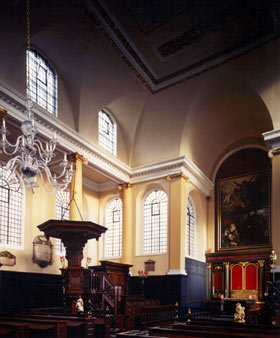 We have actually seen the boy bishop of
Hereford Cathedral taking full part in advent
ceremonies, dressed in full ecclesiastical attire. We have actually seen the boy bishop of
Hereford Cathedral taking full part in advent
ceremonies, dressed in full ecclesiastical attire.After the counter-reformation, the first Catholic mass under Queen Mary was said here. The priest had to get rid of his wife rather quickly and sold her to a local butcher and was pelted by the locals with rotten eggs. The church later became a centre of debate and the 19th C vicar, Henry Shuttleworth was the model for Mr Morell in George Bernard Shaw's 'Candida'. From Fish St Hill turn left onto Queen Victoria St and cross the road, to go through the Cleary Park terraces - site of an anciaent Roman baths, these lead to Huggin Hill, on your left is Huggin Court, which takes you to little Trinity Lane. Follow this to your right into Skinners Lane and Garlick Hill. At their intersection is ST JAMES GARLICKHYTHE . This actually used to be on the banks of the Thames - 'hythe' is a landing place. Garlick was sold here (it's relatively near the guild of Apothecaries). The current church was built by Wren in about 1680, but the steeple dates from 1717. The church was perhaps most renowned for the mummified body kept in a cupboard in the vestry. On my visit in the late 1990s I was able to see 'Jimmy' but sadly since he's retired to live in the tower. There's more on the church here. and on the Church website.  From Garlickhythe follow Skinners Lane to College Street (crossing Queen Street) and ST MICHAEL PATERNOSTER ROYAL the main feature of which is the excellent modern stained glass windows by John Hayward, perhaps the best of his craft. It has a long history, about which more here. It was almost demolished by the diocese and was only finally rebuilt and restored in 1968. As you near the end of College St, on your right is the Innholders' Hall, which dates from 1671, with restorations. Those of you tall enough will be able to see inside the windows to the excellent rooms. Turn left onto Downgate Hill, home to three beautiful city livery buildings, Dyers (1842), Skinners (rebuilt after great fire and refaced in 1778, and Tallow Chandlers (1672). Head up to Cannon St, turn right and look for Abchurch lane on your left. In a courtyard lies ST MARY ABCHURCH. Only open midday Tuesdays, but well worth the visit - Sir John Betjeman described the interior as 'one of the most beautiful in the City. Details here. The church, together with St Stephen Walbrook is the epitome of Wren. From here Cannon St leads back East to Monument Station, and the end of the walk. Notes: Search this site: |

